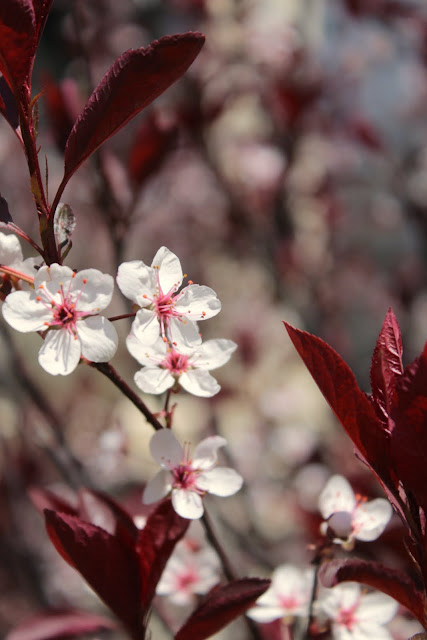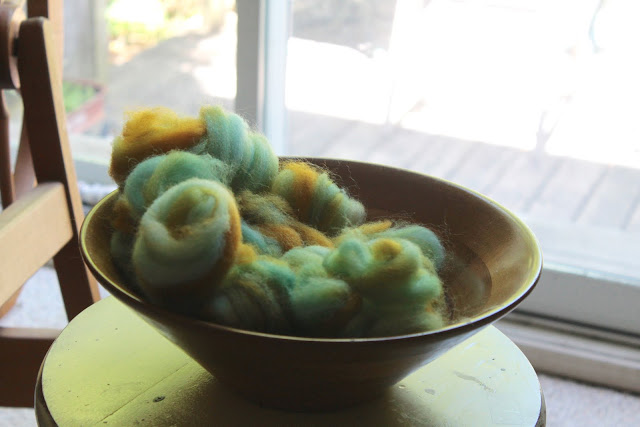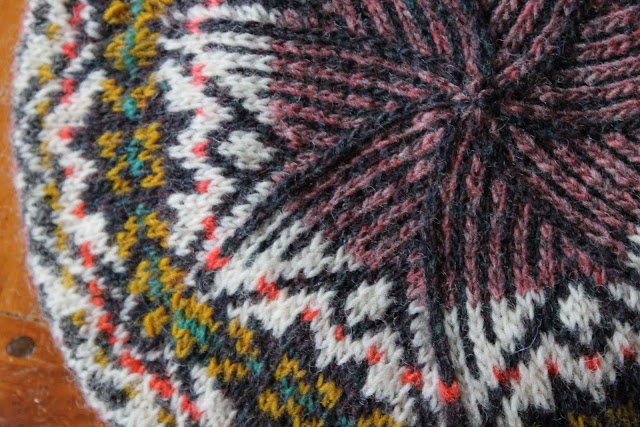Understanding the SLOW part of slow fashion, and a discussion of superwashing
This is where I was hoping to place a photography of me confidently wearing my newest sweater; an adapted version of Honeymaker, which I've made to my specs. But it was not to be, because this is what my sweater looks like now:
Don't get me wrong....it's near perfection. It has lovely 3/4 sleeves which fit more tightly than the unshaped body. I don't think that I have miss-crossed any cables, and I'm very happy with the colour. I tried it on the other day, and I think it is dense enough that I could wear it without many layers!
It's just that the collar isn't quite what I wanted. It looks good, just not what I wanted. So I'm going to rip back a few inches, and try for a boat neck.
Part of being conscious of my wardrobe choices is being willing to wait for goodness. I'm committing to slowly producing this garment, until it is wearable and I feel confident wearing it. Pieces that I am not totally happy with won't be worn. This is where the slowness of slow fashion comes in for the knitter. It means being willing to rip out and rework things, to let things sit for a little while, while I contemplate shaping, do some research, and get together the gumption to make some changes. I'm a slightly lazy person by nature. I don't mind frogging back because of lost time, instead it is mostly because I get bored.
My sweater and I are gonna stew and grumble for a few days, and then I will pull back and finish it the way I envisioned.
In the meantime, I've finished most of baby sweater. It's for my little soon-to-arrive cousin. I love having a big extended family. My plan is to make a little short sleeved cardi which will see this little girl through the 6-12 month phase this fall and winter.
I've made it from a skein of Malabrigo Rios that I've had in my stash for a while, and had trouble using. It was just a single skein, so not enough to do anything big, and although I love the colours, I don't really wear them. Contrary to what I've been knitting and buying recently, I wear a lot of neutral colours, because I do not like to stand out in a crowd. It's got a lot to do with self-confidence, and someday I'll work out the deep emotional tangle which prevents me from wearing bright colours.
The other deep emotional tangle I've been working on in recent days is my attitude towards superwash yarns. I'm pretty much against superwashing. It removes all the barbs from the wool fibres so that they cannot felt, and can be machine washable, but I'm taking a wild leap and say that any processing of fibres which requires them to sit in the presence of chlorine gas is not sustainable or minimally processed. Superwashing takes away a lot of my favourite qualities of yarn, like elasticity and "self-cleaning," and requires a tremendous amount of water to do.
So why are things superwashed? Well, machine washability. Somewhere in the last 40 years, as people lauded acrylic's easy-care tendencies, we grew to think that wool washing was a chore. Washing wool is really easy, and wool garments don't need to be washed as often because the wool fibres resist dirt and counteract odours. Superwashing was an attempt to make wool as user-friendly as acrylics. And washing wool can be fun and calming (You should hear Clara Parkes talk about blocking and washing wool, dipping the garment or swatch in lightly soaped, lukewarm water, swishing it about, and squeezing it out).
So what are the benefits of superwash yarns?
1. They are easy to wash for those who dirty clothing the most, i.e. children. For those who want wools but don't have time for the washing, it is a good option. For that reason, I can feel confident making baby wear in wool for busy parents or wool-illiterate friends. (I similarly think that acrylics have a limited, but valid place in a knitter's palette, but I don't use them often because I don't like how inelastic some of them can be while knitting. Also, they can't be easily blocked).
Some lesser known reasons I would consider using superwash yarns:
2. When pursuing colour, superwash can be brilliant. Removing the barbs means the wool just soaks up water and dye, and the results are very vivid. That's why most indie dyers are committed to using superwash. If you are looking for a very intense colour, or handdying wool in a specific shade for a specific project, I think it's perfectly reasonable to insist that superwash will get you there.
3. Projects where you want in-elastic wools or drape. I have to admit that the following argument can be made moot by using a breed specific wool, such as Lincoln Longwool or BFL, both of which has long, glossy fibres that will drape rather than pull together. But, superwash wools grow considerably more in the blocking bath than non-superwash, and stay that way. If you want a flowing garment, this is wonderful. Consider lace knitting, where blocking opens up the stitches, but a few hours after wear the garment shrinks back a bit, and the lace is less striking. This isn't true of lace knit in superwash.
I think superwash really isn't sustainable, but it's unique characteristics might also prove useful in crafting. It's a question close to my heart: Should I ever design in superwash, should I ever sell superwash yarn?
I think the answer to both those questions is yes. Yes, I would, if the project demanded it. The wool industry isn't going to change overnight, but I can be one of the many knitters who are helping to change that by using breed-specific and single-source yarns more often, buyers and sellers. But I can also advocate LIMITED USE for these products, recognizing their benefits for a SELECT range of problems. Again, SELECT and LIMITED use, sometimes. ;p







Comments
Post a Comment